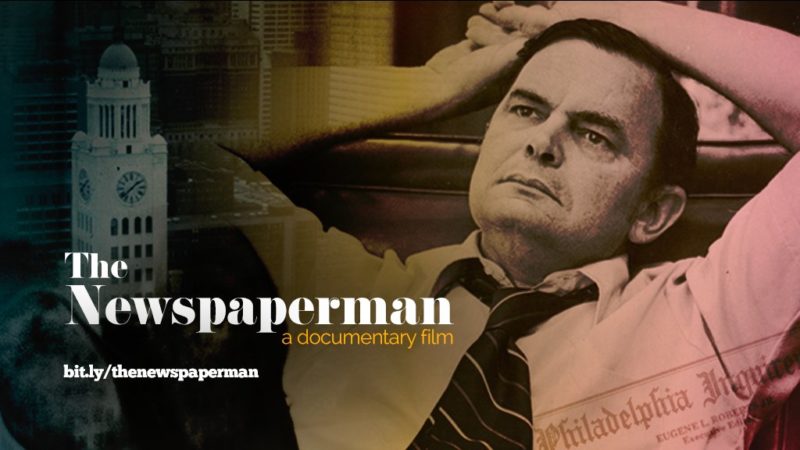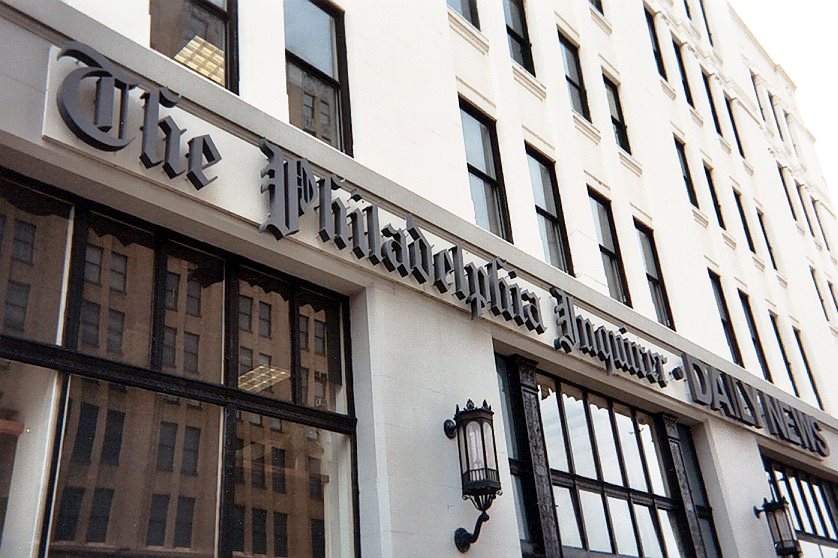Sign up for The Media Today, CJR’s daily newsletter.
David Layton and Mike Nicholson have been working for four years on their documentary about the great newspaper editor Gene Roberts. But as they approach the finishing kick for their labor of love, it seems that the long wait has a silver lining.
The emergence of Donald Trump, known for his hostility to the press and his fast-and-loose approach to the truth, has brought with it a renewed respect for the importance of ambitious, aggressive, fact-based accountability journalism. That’s a commodity that perfectly sums up Roberts’ approach.
A former New York Times reporter and editor, Roberts is legendary in journalism circles for masterminding the turnaround of The Philadelphia Inquirer, from one of the worst metro dailies in the country to a journalism superstar, winning 17 Pulitzers in the 18 years Roberts was at the helm from 1972 to 1990.
While it’s been 27 years since the soft-spoken North Carolinian stepped down from his editing post to teach journalism at the University of Maryland, Roberts remains an inspirational figure in journalism circles, regarded as one of the very best if not the best editor of the second half of the 20th century.
But his rise from the tiny Goldsboro News-Argus to the pinnacle of his craft remains little known to the general public. Layton and Nicholson hope to change all that, and they believe the timing couldn’t be better.
“We’re getting some interest we wouldn’t have gotten a year ago,” thanks to Trump’s “animosity to the press,” says Layton, whose father, Charles, was an Inquirer mainstay during the glory years. He senses a much deeper appreciation for “hard-hitting journalism with a code of ethics that looks under rocks.”
The co-producer/directors detect a sense of urgency in the last few months when they talk about the project, both among film insiders and the general public. At Layton’s birthday party last year after the election, Nicholson recalls a woman approached him and said forcefully, “You’ve got to make this documentary.”
Layton and Nicholson, who have a documentary production operation in Austin, have thus far, aside from a $25,000 Knight Foundation grant, funded the project on their own, spending about $35,000. A couple of times a year they hop into a van and travel the country, shooting interviews themselves. They’ve done 31 so far, talking to many key figures from the Roberts era in Philly.

Courtesy photo
On April 4, they launched a Kickstarter campaign to raise $150,000 to hire an editor, an assistant, and an archivist so they can finish up the project in the fall. The goal is to release The Newspaperman in time for next year’s movie festival season.
It’s an all-or-nothing campaign; if they don’t raise the full amount by May 3, they don’t get to keep any of the money. As of April 11, more than $57,000 had been pledged.
Roberts has been, among many other things, a prodigious fundraiser. (He once spearheaded an effort that brought in a seven-figure haul to keep Columbia Journalism Review and American Journalism Review afloat.) Says Layton, “I often get the feeling that Gene thinks if he’d been raising the money, this film would already have been made.”
***
It was my privilege to have a close-up, at times uncomfortable, view of the the Roberts magic at work.
I started my career at The Philadelphia Inquirer, pre-Gene, so I know just how bad it was. The stories of then-owner Walter S. Annenberg’s penchant for using his paper to punish his enemies and reward his friends are legion. It was very clear to me just how heavy a lift it was to raise this daily to greatness.
With my unerring instinct for the good career move, I had left the paper in 1969, about six months before it was sold to Knight Newspapers (later Knight Ridder), to join the then-larger and more prestigious Philadelphia Bulletin, an afternoon paper that offered me the opportunity to join its Washington bureau.
Knight was known for the quality of its newspapers. Its first executive editor at the Inquirer, John McMullan, deserves major credit for starting the rebuilding process, establishing standards, removing dead wood and bringing in talent. When Roberts took over in 1972, his trademarks were soon apparent: hiring and developing excellent journalists; establishing a climate where talent could flourish; thinking big, seriously big; fostering formidable journalism; above all, creating the sense that all things were possible. These were golden days for newspapers, and big spending was always part of the Roberts formula.
As the Inquirer rapidly became better and better, the Bulletin retreated. A painful memory: In 1979, when the nuclear accident at Three Mile Island in central Pennsylvania took place, I was the Bulletin’s deputy metro editor. We jumped on the story quickly, dispatching reporters to the scene, about 100 miles from Philadelphia. Much to my chagrin, it wasn’t long before I was ordered to bring the troops back; Three Mile Island was awfully far away. Meanwhile, Roberts was sending platoons of reporters to the scene, emptying an entire large suburban bureau in the process.The result was superb journalism and one of those Pulitzers.
Without robust journalism, we’re doomed.”
Years later, I got to know Roberts well when I was running American Journalism Review, based at the University of Maryland’s J-school, where Gene was teaching. A great believer in AJR and journalism reviews in general, Roberts was a tireless and relentless ally. I don’t know which impressed me more, his commitment to excellence or his iron will.
In the late 1990s, Roberts raised what ultimately was nearly $2.5 million from the Pew Charitable Trusts for the Project on the State of the American Newspaper, a collection of 18 25,000-word pieces that ran in AJR.
Our one bad moment: AJR was about to go to press with a piece on Washington coverage. Turns out Gene wanted to do a much more extensive article for the Project. He came to my office to talk about it. He was adamant that we hold off for the series. I wanted to run it now. We went back and forth, neither of us giving ground. Finally Gene—rather than point out that he was Gene Roberts and I certainly wasn’t and squashing me like a bug—turned to me and said, “Rem, you can see how passionate I am about this. What are you equally passionate about on the other side?” He was right, of course; an examination of DC coverage ran as part of the Project.
Roberts and The Washington Post’s late Ben Bradlee are often cited as the two top editors of their time. And they couldn’t be more different in style, Bradlee with his riverboat gambler swagger, Roberts with his deceptively quiet manner and long pauses. I remember telling an associate after she met Roberts and remained undazzled, “You just had lunch with Michael Jordan.”
I asked a couple of journalists who had worked closely with Roberts in Philadelphia what they thought were the keys to his success.
Bill Marimow, who spent 18 years with Roberts, thinks Roberts’ solid reporting background is a big part of the equation. ”In towns and cities from Goldsboro, North Carolina, to Saigon, he covered beats like agriculture, the waterfront, labor, the South during the civil rights era and the Vietnam War,” says Marimow, until recently the Inquirer’s top editor and is now editor at large. “That experience gave him both the credibility with newsroom staffers of every age … and the experience to mentor younger staffers.”
He adds, “Gene also knew talent when he saw it—whether it was a colleague or competitor—and he had the persuasive power to get others to believe in his dream.” Once Roberts had lured the talent to his newsroom, Marimow says, “Gene had the wisdom and the confidence in his own leadership ability to give them the latitude to pursue great stories.”
Charles Layton, the filmmaker’s father, says that Roberts “practically invented thinking big. He doesn’t know how to think small. I’ve seldom brought him a story without him telling me how it could be expanded or deepened or clarified. He sees the bedrock importance of stories, and he’ll tell you how to emphasize that.”
Another key, says Layton, is Roberts’ preparation. “I’ve never seen him unprepared,” says Layton, who spent 22 years at the Inquirer, 16 under Roberts, and wrote major pieces for the Project on the State of the American Newspaper. “He came to Philadelphia never having lived there before, but almost from day one he seemed to understand the city better than people who’d grown up there.”
And there’s his gift for assessing people. “He reads people’s minds and emotions, and can assess their strengths and weaknesses,” Layton says. “It’s like he has x-ray eyes.”
***
When David Layton was a lad, he loved to visit his father at the Inquirer, often sprinting past the security guard and making his way to his father’s desk in the newsroom. “It was a magical place,” the younger Layton recalls. “People were excited about their jobs. There was a lot of wit and jokes.” And Roberts was a “mythic figure.”
Years later, Layton got into the documentary business, and after awhile he wanted to make his own film. By this point he had teamed up with Nicholson. Layton thought about climate change and opioid addiction as potential subjects. But he kept coming back to Gene Roberts.
Nicholson, for his part, was “obsessed” with doing something on the media. But the potential subjects “tended to be bummers,” he says, “big bitchfests about the media.”
Finally, they contacted Roberts, who agreed to meet with them for five days in his redoubt in Bath on North Carolina’s Inner Banks, once the home of Blackbeard, the noted pirate. The filmmakers would interview Roberts by day, and at night they’d go through material from the Roberts archives that Gene’s wife, Sue, had provided. By the time they left, they were hooked.
Since then, they’ve conducted more than 30 interviews, talking with many key Inquirer figures, journalists who knew Roberts at the Times, and Tony Ridder, the Knight Ridder honcho who battled with Roberts over budgets at the end of Roberts’ Inquirer tenure.
Several key players are dead, but Layton and Nicholson have access to interviews from The Unnatural, the film shot in Roberts’ honor when he left the Inquirer.
Layton and Nicholson plan to use the Inquirer transformation as the movie’s narrative thread, tying specific events to Roberts’ previous reporting and editing career, his experiences covering civil rights and Vietnam.
For example, when he was with the Detroit Free Press, Roberts wrote a detailed reconstruction of the Kennedy assassination. After the Three Mile Island accident, in addition to assigning all of those reporters to deal with the fast-moving breaking news, he detailed a separate team to immediately focus solely on putting together a definitive tick-tock.
Although they already have 80-plus hours of material to whittle down, a powerful editing challenge, the filmmakers plan to do a handful of final interviews to fill in the gaps once the structure of the film takes shape.
And Layton and Nicholson are convinced that their baby will have appeal to an audience that goes well beyond journalism junkies, particularly in an era where the truth is challenged by “alternative facts.”
“The stakes couldn’t be higher,” Nicholson says. “Without robust journalism, we’re doomed.”
Has America ever needed a media defender more than now? Help us by joining CJR today.



